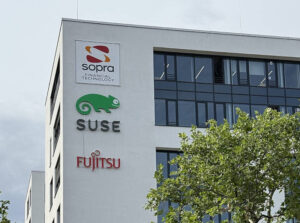SUSE’s latest updates tightly link its Rancher Kubernetes platform and new AI stack, signaling a move to simplify AI management across environments.

On Tuesday at KubeCon in Atlanta, SUSE brought news on two fronts. The first is containers, last decade’s technology of the future that’s now the backbone of enterprise IT infrastructures. The second is AI, the current future vision that seems certain to be essential long before the end of this decade.
At KubeCon, even when SUSE was talking about containers, AI was at play, starting with major improvements to SUSE AI, the company’s AI offering that’s now available as something of a standalone stack built on Rancher. In addition, and evidently separate from the AI/ Rancher stack, there’s now tight AI integration in its Rancher Kubernetes platform.
SUSE’s move to AI shouldn’t be much of a surprise. It was only a little more than a week ago that it announced a technology preview in SUSE Linux Enterprise Server that can be used to put agentic AI in charge of running mission critical operations.
SUSE AI — Better than DIY?
The current trend in AI is for enterprises to build their own AI implementations tailored to their unique needs, which they can then continuously tweak to meet ever changing needs. In Tuesday’s announcement, SUSE counters this approach by pointing to IDC research, which indicates that by 2028, 65% of do-it-yourself agentic AI projects will be abandoned as organizations began to get a handle on the actual costs associated with DIY AI.
To make its case, SUSE quotes IDC research manager Michele Rosen:
“IDC’s research shows that enterprises are struggling to bring complex GenAI projects to production due to fractured integrations and a lack of control, which is why unified platforms that simplify operationalization are essential for securely accelerating AI adoption and maximizing business value.”
SUSE’s AI-related announcements seem to check all the “simplify operations” boxes that Rosen’s comment suggests. At the same time, they open the door for the customization that enterprises with numerous use cases will need.
Inside SUSE AI
The SUSE AI platform is a stack built on the Rancher Prime Kubernetes platform, an integration that makes it possible to operate SUSE AI consistently across public or private clouds, on premises, and even in air-gapped environments using SUSE’s air-gapped installation process for containers. It also directly addresses requirements for data security and digital sovereignty, ensuring enterprises maintain control over business data and proprietary intellectual property.
SUSE says that other ways the platform provides seamless operations, and reduces hidden costs includes:
- Universal Proxy: The platform takes advantage of the Model Context Protocol to connect to external systems, data sources, and tools, and its integrated MCP proxy –available as a tech preview — simplifies connections by creating centralized management for MCP endpoints, optimizing model costs and enhancing data access control. This follows SLES 16‘s introduction of MCP components.
- Accelerated AI Inference: Expanded inference engine portfolio includes high-performance platforms like vLLM to deliver fast, highly efficient, and scalable LLM inference, simplifying the process of moving AI models into production.
- AI Observability: Extending the core capabilities of SUSE Rancher Prime, SUSE AI includes the OpenTelemetry operator for auto instrumentation. In addition, this release of SUSE AI includes out-of-the-box observability for Ollama, Open WebUI, Milvus via Open WebUI Pipelines, and enhanced observability metrics for performance and predictability.
New in SUSE Rancher Prime
SUSE AI isn’t the only platform the company is getting to show off at KubeCon. Considering that “Kube” is short for Kubernetes — Rancher’s forte — it only makes sense that SUSE would be rolling out new Rancher features at the event. In addition, Rancher is essential to its portfolio, a key ingredient to the company’s “SUSE” branded AI and Edge solutions.
Here again, Rancher Prime’s new features start with AI:
- Simplified Management with Agentic AI: In another tech preview, SUSE Rancher Prime now includes Liz — short for Lizard — a context-aware AI agent that simplifies Kubernetes management, helping teams to proactively detect issues, optimize performance, and reduce resolution times for customer issues.
- Virtual Clusters: Now generally available, SUSE virtual clusters — which are fully functional, isolated Kubernetes cluster environments that run nested inside a larger “host” cluster — help enterprises optimize their GPUs.
- Full Stack Management: For organizations running SUSE from the top of the stack to the bottom, Rancher Prime enhances and further simplifies the management of the full SUSE stack, from the operating system to workloads.
- VMware Modernization: This one might be more important than a mere bullet point might suggests, since looking for ways to break their VMware dependency post-Broadcom is almost as big a trend as AI.
The latest SUSE Virtualization version provides advanced network functionality — also in tech preview — that includes micro-segmentation. This decouples network functions from physical hardware, allowing for software-defined networking that increases agility, scalability, and automation for virtual machines and containers.
In addition, SUSE Virtualization’s ecosystem of certified enterprise storage providers has been expanded to include Fujitsu, Hitachi, HPE, and Lenovo, expanding customers’ ability to leverage their existing storage investment.
Expanded Observability: SUSE Observability now includes a dashboard editor so users can visually organize operational data into shared, actionable insight leading to faster incident resolution times. It also adds support for the OTel framework — an open-source standard for collecting, processing, and exporting telemetry data — enabling SUSE Observability to provide unified visibility and insights outside of the Kubernetes landscape.
SUSE also announced SUSE Rancher Developer Access, a UI extension for using Rancher Desktop to access SUSE Application Collection, a curated library of open source apps and container base images delivered by SUSE.
Christine Hall has been a journalist since 1971. In 2001, she began writing a weekly consumer computer column and started covering Linux and FOSS in 2002 after making the switch to GNU/Linux. Follow her on Twitter: @BrideOfLinux







Be First to Comment